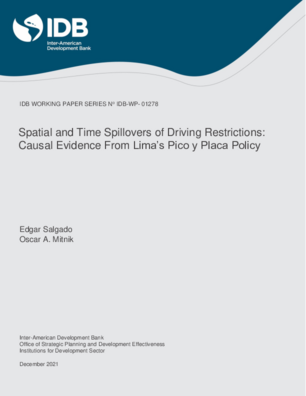Spatial and Time Spillovers of Driving Restrictions: Causal Evidence from Limas Pico y Placa Policy
Date
Dec 2021
Driving restrictions are popular interventions in rapidly urbanizing developing countries. Their relatively inexpensive implementation appeals to the pressing need to reduce traffic congestion and pollution. Their effectiveness however, remains contested. Using high frequency data from the community-based driving directions app Waze, we evaluate the causal effect on traffic congestion of Lima's Pico y Placa driving restriction policy introduced in 2019. We find small improvements in traffic congestion for the policy's directly targeted areas. However, those improvements are offset by time and spatial spillovers in the opposite direction in the aggregate. Speed improved by 2 percent during the early weeks of the intervention, but this effect disappeared 16 weeks after the start of the policy. Moreover, traffic conditions worsened in adjacent areas and in hours outside the time schedule of the policy. In the aggregate, accounting for time and spatial spillovers, a simulation exercise suggests that overall welfare declined by 2 percent, mostly driven by the extensive margin (more roads becoming congested) outside the direct areas and hours targeted by the policy. The policy seems not only to have failed to achieve its intended benefits in terms of congestion, but also probably caused increases in traffic-related pollution. These results highlight the need for policy makers to take into account the overall impacts of driving restrictions policies before implementing them.
Generative AI enabled





